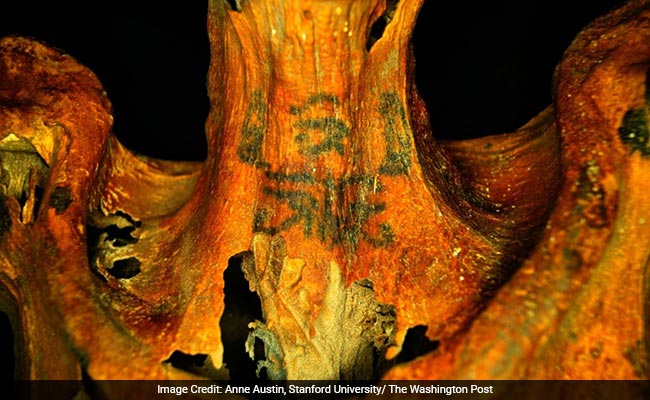
Anne Austin began her inspection of the 3,000-year-old body and found that the body was tattooed when she was alive.
Upon closer examination, however, Austin and her colleagues realized the designs were permanent, having withered and warped by time but also the act of postmortem preservation. The woman had been tattooed, the scientists determined, when she was alive.
“The markings at the neck were the clearest, and the symbols for them were instantly visible,” the archaeologist wrote in an email to The Washington Post. “However, it was only after looking more closely at the markings on the arms that we realized they had become distorted from the mummification process.”
Austin, along with researchers from the French Institute of Oriental Archaeology, had been examining a body uncovered at Deir el-Medina, Egypt, a village near the Nile River that once housed the workers who designed and constructed the pharaoh’s tombs in the Valley of the Kings. During Deir el-Medina’s peak – which would have been between 1292 to 1077 B.C., according to Stanford University – its residents were both literate and prolific, leaving behind the remnants of thousands of prayer notes, lawsuits and letters that researchers would find much later. Austin also believes the town practiced a precursor, of sorts, to modern medical coverage; in 2014, she said artifacts from Deir el-Medina show evidence of “the earliest documented governmental health care plan.”
The residents of Deir el-Medina, it seems, also knew their way around a tattooing needle. Austin documented the mummy’s blue lines with infrared photographs and other advanced imaging equipment, and identified about 30 different tattoos etched into the woman’s arms, shoulders, back and neck. She was dotted with cow figures, snakes, lotus blossoms and symbolic eyes.
“Many of the tattoos are linked with the goddess Hathor, including two cows wearing Menat necklaces on her arm,” Austin said. ( Menat necklaces were heavy, beaded adornments closely associated with Hathor.) “The deeply religious imagery of the tattoos suggests that this woman had an important and unique religious role.” Austin believes the woman’s religious position was likely both permanent and public, as her tattoos were inked in visible areas of her body.
Though an unexpected find, the woman’s tattoos are not the oldest in human history. That claim, as far as the archaeological record shows, is thought to belong to Otzi the Iceman, who lived some two millennia before the woman with the bovine tattoos. Otzi’s 5,000-year-old body shows preserved ink marks, mostly groups of lines, in 61 places across his chest, legs and arms.
What makes the tattoos Austin found noteworthy is the fact they show identifiable representations of animals, plants and other objects. Austin told The Post that previous research had found Egyptians with tattoos in the “Nubian tradition,” that is, “geometric patterns of dots and lines.” The complex designs seen on this woman are, Austin said, unprecedented.
The Egyptians who lived thousands of years ago had a surprising wealth of knowledge about the human body, even applying honey to wounds as an antibacterial salve. But the inner workings of whatever passed for a 3,000-year-old tattoo parlor remain a mystery. “It is difficult to determine how tattoos were made in the past, and given the scant evidence so far, we can’t say how her tattoos were applied,” Austin said. “It is interesting, however, to see that some of the tattoos are placed in incredibly sensitive areas of the body, such as the neck, where tattooing would be comparatively painful.”
Austin presented her findings in April at an anthropology conference. “The purposeful placement of divine imagery along the arms and neck enabled the tattoos to be ritually active during religious cult activities,” she noted in the conference abstract, “thereby embodying the divine.”
© 2016 The Washington Post
(This story has not been edited by NDTV staff and is auto-generated from a syndicated feed.)
